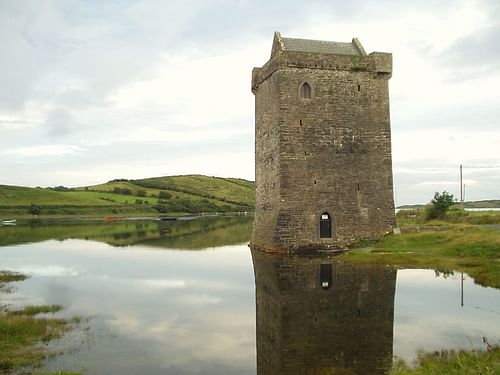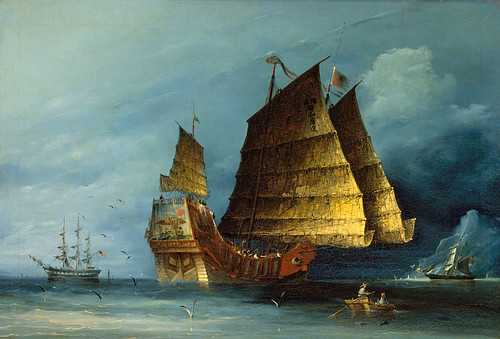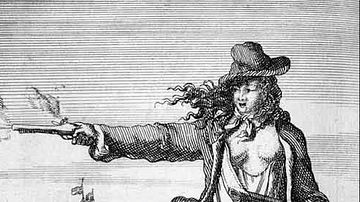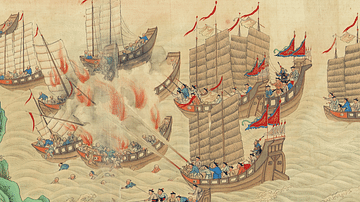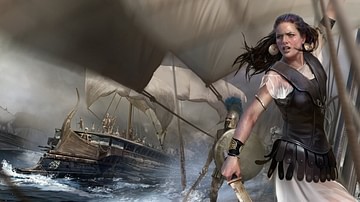In this article, we look at the lives and deeds of seven notorious women pirates. There is Teuta, the Balkan enemy of ancient Rome; Alwilda, the Scandinavian princess who chose a life of crime on the High Seas; Maria Lindsey, who terrorized the northern Atlantic; the Irish pirate and folk hero Grace O'Malley; the widow Zheng Yi Sao, who led a huge Chinese pirate fleet; and two figures from the Golden Age of Piracy (1690-1720) in the Caribbean: Anne Bonny and Mary Read.
Women at Sea
We may think that women at sea were a rare occurrence through history, but this is not necessarily so. Much depends on time, place, culture, and, of course, opportunity. Wives of European captains and officers, for example, sometimes accompanied their husbands at sea on merchant vessels. Some wives of men who had been press-ganged into joining a naval ship smuggled themselves aboard a vessel and only revealed themselves when the ship was at sea. There are, too, historical cases of women sometimes fooling their peers on board merchant ships of the period by disguising themselves as young men. Then there are women who openly joined men in working at sea, fishing and whaling being industries where women were not an uncommon sight on a ship in several oceans over many centuries. British warships often had female servants on board, and in some cultures, notably in Asia, women were not only mariners but also captains of fishing and merchant vessels.
How many of these women mariners then became pirates is difficult to assess. Many male pirate captains in the Caribbean, for example, created articles that strictly prohibited women and young boys on board their ships to avoid any squabbles over sexual favours or predatory behaviour. However, we do know of certain specific cases, women of legend, folklore, and fact – as attested by historical sources such as trial records – who were pirates. We also know that pirate vessels carried wives of pirates who did not themselves participate in fighting and so were released from trial when their husbands were captured. Then there are those women, including monarchs, who sponsored men to act as pirates for them, either for personal gain or to promote the interests of their state. Here, then, are seven such women who have left their mark on the long history of women at sea.
Teuta (3rd Century BCE)
Teuta was a queen of the Ardiaei, an Illyrian tribe located in the western Balkans. She was known for her association with piracy, and here is her story. As the second wife of King Agron (231 BCE), she ruled as regent for her young step-son Pinnes when her husband died. Teuta continued her husband's aggressive foreign policy, pursuing the siege of Issa in 230 BCE and attacking vessels in the Adriatic Sea with her own fleet of fast, light ships. The Romans sent envoys to Teuta's court to negotiate an end to what they considered acts of piracy. At least, this is how the situation was presented by the 2nd-century BCE Greek historian Polybius. However, at this time in history, there was not a great deal of distinction between piracy and warfare. Teuta's ships may have attacked merchant vessels but they also attacked military targets like Corfu (Corcyra) and the combined navies of the Achaians and Aitolians.
As a consequence of one of their envoys being killed en route by Illyrian pirates, Rome declared war in 229 BCE. However, the true events are difficult to determine from the conflicting sources. It may be that the envoys met Teuta and were killed on her orders during the return journey. According to Polybius, Teuta told the Roman visitors that she could not prevent her subjects from pursuing piracy as they had always done so. Alternatively, it is possible neither envoy ever met the queen. Teuta was ultimately betrayed by Demetrius of Pharos who bargained with the Romans, offering his aid and Corfu (Corcyra) as a bargaining chip. The Romans were victorious in the First Illyrian War in 228 BCE, and Teuta's kingdom was much reduced in size as a consequence. Demetrius was made Pinnes' guardian while Teuta retreated to Rhizon (modern Risan in Montenegro). The queen then signed a peace deal with Rome, promising to pay a regular tribute and not permit more than two of her "pirate" ships to ever sail south of Lissos (in modern northern Albania) at any one time.
Alwilda (5th century)
Alwilda (aka Awilda or Alvilda) is a legendary pirate from what is today Sweden whose deeds are presented in the History of the Danes compiled by the monk Saxo Grammaticus (active 1185-1208). Alwilda took to piracy in the 5th century when she refused an arranged marriage with Crown Prince Alf of Denmark. Disguising herself as a man, she made off with a boat and was accompanied by a group of her most trusted female companions. Alwilda then met up with a bunch of pirates who, having recently lost their captain, saw her as an ideal replacement. Alwilda was rather good at piracy, stalking ships in the Baltic and causing such havoc, the king of Denmark sent a force to apprehend her. Ironically, the man selected to lead the Danes was none other than Prince Alf. Alwilda and her pirates put up a good fight in the Gulf of Finland but not only did Alf win the battle he also, at last, won the affections of Alwilda who was impressed with this gallant man of action. The pair married and so Alwilda did eventually become the queen of Denmark.
Grace O'Malley (c. 1530-1603)
Grace O'Malley was born in Connaught, Ireland around 1530. Grace acquired the nickname of Granuaille ("the bald one") since she wore her hair very short – perhaps as this was better suited for life on a ship – and she has become an enduring figure of Irish folklore. She was the daughter of a chieftain who ruled around Clew Bay. As a child, she raided eagle's nests after the birds had attacked her father's sheep. The eagles scratched Grace's forehead with their talons and she bore these scars for the rest of her life.
Aged 16, Grace married Donal O'Flaherty, and they lived in his castle at Bunowen. She had three children, but when her husband died, she was obliged to move out since at that time women could not inherit property. In this way, Grace turned to piracy, commanding a fleet of 20 of her father's ships and raiding the cargoes of merchant vessels. In battle, the Irish leader fought personally with pistols and cutlass. Grace also used her ships for legitimate business, but it was her piracy and extraction of tribute from passing ships (or allegations of so doing) that led the English Royal Navy to send ships against her, ships which Grace defeated on more than one occasion. Despite this friction, Grace's fleet did at one time or another sail in the service of Elizabeth I of England (r. 1558-1603), perhaps following the advice of her second husband, the Irish chief Richard Burke (m. 1566).
Grace was captured while attacking the estates of the Earl of Desmond in 1577 and imprisoned in Limerick for 18 months as the strife between England and Ireland intensified. In September 1593, Grace was granted an audience with Queen Elizabeth, perhaps to negotiate the release of one of her sons, and she was awarded a regular maintenance, most likely in return for lending her ships to assist Elizabeth's policies in Ireland. The affection between the two parties was strengthened when Grace's son Tibbot was knighted by the English queen and he became Sir Theobold. By 1597, Grace's fleet was back in operation, and she likely died of old age at Rockfleet Castle in County Mayo in 1603. According to one legend, Grace had buried over nine tons of gold treasure, but she protected this with a curse, and it has never been found yet.
Anne Bonny (active 1719 to 1720)
Anne Bonny (also Bonney) was born in Ireland (1690 to 1700) and earned infamy as a pirate in the Caribbean. She left her husband in 1719 and sailed with her lover John Rackham, aka 'Calico Jack'. Amongst their crew was another woman, Mary Read. Bonny dressed as a male mariner, at least when in battle. The pirates did not make any significant captures, and Bonny's only real claim to fame was that she was a woman in a man's world of crime at sea. She seems to have easily held her own in this environment and fought courageously with pistols when required. Bonny and Rackham had a child, but they abandoned the infant in Cuba.
Bonny was captured when her ship was boarded by the authorities near Jamaica in November 1720. Only Bonny, Read, and one other man put up any resistance as Rackham and the rest of the crew were drunk. She was tried for piracy, found guilty, and sentenced to be hanged, but her execution was delayed when the court found out that she was pregnant. Rackham, meanwhile, was hanged but Bonny had little sympathy for him, stating: "If you had fought like a man you wouldn't be hanged like a dog" (Downie, 193). Bonny never did meet justice, and her ultimate fate is uncertain.
Mary Read (d. 1721)
Mary Read (also Reade) was born around 1690 in some sources, in others at least a decade earlier, probably in Plymouth, England. Mary's elder brother died as a child, and her mother pretended Mary was the boy to continue receiving financial help from her late husband's mother. Continuing the ruse of dressing up as a boy, Mary gained employment as a footman but decided that a life at sea would offer more opportunities for adventure. Still in disguise, Read joined a naval vessel and then the army so that she participated in the Nine Years' War (1688-97) against the French. Falling in love with a cavalry officer, the pair entered civilian life and ran a public house in the Netherlands called the Three Horse Shoes. Read's husband died, and her business went bust; so she joined the crew of a ship and headed for a new life in the Caribbean.
Read fell in love with a mariner on her ship who was challenged to a duel. Stepping in to fight the challenger, Read killed him with her sword and pistol. Read's ship was then captured by pirates, and she joined them in 1717, either voluntarily or under threat of being killed for not joining. This is perhaps how Read joined the crew of John Rackham. Like Anne Bonny, who was also in this crew, Read wore men's clothes in battle and fought alongside the other pirates, a point attested by trial witnesses. Small-time pirates, Read and co. concentrated on relieving such cargoes as tobacco from small and poorly-armed merchant ships.
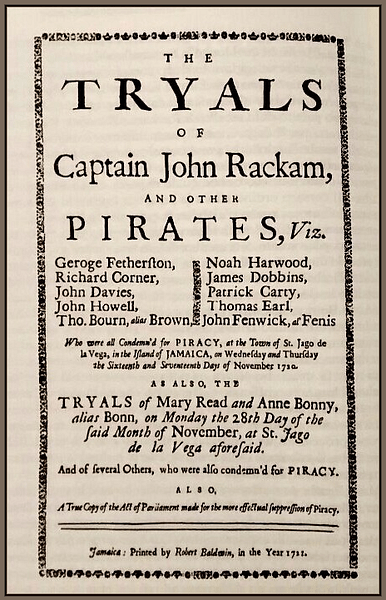
Read was captured along with Bonny and Rackham in November 1720 when the Jamaican authorities surprised their sloop, and nobody else but the two women and one man put up any resistance. As one witness noted: "both [Read and Bonny were] profligate, cursing and swearing much, and very ready and willing to do anything on board" (Cordingly, 111). Like Bonny, she was tried for piracy, found guilty, and sentenced to be hanged. Also like Bonny, her sentence was delayed because she was pregnant. Mary Read died in prison of fever in 1721.
Maria Lindsey (early 18th century)
Legendary Englishwoman Maria Lindsey (aka Cobham) formed a pirate partnership with her husband Eric, the pair having met at Portsmouth when Eric Cobham was already an established pirate. They prowled the waters around Cape Breton in the western Atlantic in the early 18th century, particularly focussing on ships carrying valuable furs. Notorious for their cruelty to captured mariners, a number of their victims were once tied up in sacks and thrown overboard. Maria was said to have stabbed a rival captain and used prisoners as target practice for her pistol skills. Having done exceedingly well as pirates, the Cobhams bought a plush estate in Le Havre, owned a yacht, and settled down to a more respectable life. Things turned sour when one day out sailing they seem to have been tempted back into their old ways. They captured a brig, murdering the crew in the process, and then sold it in Bordeaux. The Cobhams calmly resumed their cloak of respectability, Eric Cobham even becoming a local magistrate of all things. Tragedy then struck when Maria committed suicide by ingesting poison and jumping off a cliff.
Zheng Yi Sao (d. 1844)
Zheng Yi Sao (aka Ching Shih) took over her late husband Zheng Yi's massive pirate fleet that plagued the South China Sea in the early 19th century. The pirate widow expanded operations and the fleet rose to over 800 ships with 70,000 men, all organised into six fleets that each hoisted a different colour flag. Particular targets were merchant ships carrying goods like silk, spices, and porcelain to and from Canton (now Guangzhou) and Malaysia. Foreign ships were also victims, and their mariners frequently found themselves held until a ransom was paid. Coastal settlements suffered regular and brutal attacks. Zheng Yi Sao's control of these waters was so complete that captains were obliged to pay protection money and so acquire a pass that would guarantee immunity from any ship in the pirate fleet. Even naval fleets could make little impression on the pirates' total control; three separate fleets were defeated by the pirates in 1808 and 1809.
Women would have naturally preferred not to have been kidnapped at all, but at least those who were captured by Zheng Yi Sao's crews were offered greater protection than elsewhere. Meticulous in her record-keeping and rules, Zheng Yi Sao's pirates were not permitted to molest captured women, the punishment for such an offence was death.
There were some troubled waters for Zheng Yi Sao. Her lover and leader of the Red Flag Fleet was Chang Pao (c. 1786-1822). The leader of the 100-ship Black Flag Fleet, Kuo P'o-Tai, was jealous of Chang Pao's elevated role; he may even have been jealous of his monopoly of Zheng Yi Sao's affections. Chang Pao even attacked Kuo P'o-Tai's fleet in December 1809. With her pirate confederation breaking up, Zheng Yi Sao decided to call it a day. The pirate chief boldly sailed to Canton and negotiated a pardon from the governor in April 1810. Zheng Yi Sao married Chang Pao and then ran a smuggling operation until her death in 1844. Many have argued that Zheng Yi Sao was the most successful pirate, male or female, of all time.


